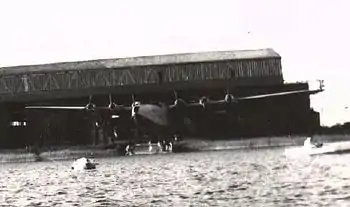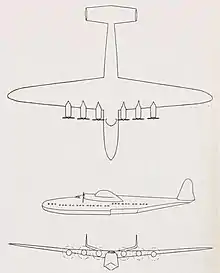Latécoère 631
The Latécoère 631 was a civil transatlantic flying boat built by Latécoère, the largest ever built up to its time. The type was not a success, being unreliable and uneconomic to operate. Five of the eleven aircraft built were written off in accidents and one was lost during World War II.
| Latécoère 631 | |
|---|---|
 | |
| Latécoère 631 - Wharf of Biscarrosse Lake | |
| Role | flying boat |
| Manufacturer | Latécoère |
| Designer | Pierre-Georges Latécoère |
| First flight | 4 November 1942 |
| Number built | 10 (plus the prototype) |
Design and development
The Latécoère 631 was the result of a specification issued in 1936 by the Direction Générale de l'Aviation Civile for a 40-passenger airliner with a range of 4,000 kilometres (2,500 mi). The aircraft was ordered in 1938. It was intended that it would be powered by six Gnome et Rhône P.18 engines of 1,650 horsepower (1,230 kW) each. A competitor for this specification was the SNCASE SE.200 Amphitrite.[1]
Construction of the aircraft was stopped due to the outbreak of World War II and was not resumed until after the signing of the Franco-German Armistice.[1] The prototype, registered F-BAHG, first flew on 11 November 1942. It was subsequently confiscated by the Germans,[1] and passed to the Luftwaffe, who allocated the codes 61+11.[2] The aircraft was flown to Lake Constance, where it was destroyed in an attack by two Royal Air Force de Havilland Mosquito aircraft on 17 April 1944.[1] SNCASE SE.200 Amphitrite 20+01 was destroyed in the same attack.[2]
History
The second aircraft, F-BANT, first flew on 7 March 1945. It was powered by six Wright Cyclone engines of 1,600 horsepower (1,200 kW) each.[1][3] Four aircraft were purchased by Air France, and entered service on the Biscarrosse-Port-Étienne-Fort de France route in July 1947. The aircraft were withdrawn from service in August 1948 following the loss of F-BDRC. SEMAF operated two aircraft until 1950, when the survivor was withdrawn following the loss of F-BANU. The Société France Hydro operated one aircraft until it was lost on 10 September 1955.[1] This was the last flying aircraft,[4] with the remaining four survivors being scrapped. The Latécoère 631 was not a success due to it being unreliable and uneconomic to operate.[1]
Accidents and incidents
- On 31 October 1945, Air France's F-BANT was operating a flight from Rio de Janeiro, Brazil, to Montevideo, Uruguay, and Buenos Aires, Argentina, when the propeller of No. 3 engine separated in flight, damaging No. 2 engine. A propeller blade sliced a 3 metres (9.8 ft) hole in the cabin, killing two passengers. A fire started and an emergency landing was made in the Laguna de Rocha, Uruguay. The aircraft was subsequently repaired and returned to service.[3] The celebrated poet, diplomat and composer Vinicius de Moraes and writer Rubem Braga, both Brazilians, were on board.
- On 21 February 1948, Latécoère's F-BDRD crashed into the English Channel off Saint-Marcouf, Manche, in a snowstorm with the loss of all nineteen people on board. The aircraft was being delivered from Saint-Malo, Ille-et-Vilaine, to Biscarrosse, Landes.[1][5]
- On 1 August 1948, Air France's F-BDRC crashed into the Atlantic Ocean with the loss of all 52 people on board. The aircraft was operating a flight from Fort de France, Martinique, to Port-Étienne, Mauritania. Following this loss, the Latécoère 631 was withdrawn from service by Air France.[1][5] The United States Coast Guard ship USCGC Campbell reported finding debris on August 4 but no sign of survivors.[6]
- On 28 March 1950, SEMAF's F-BANU crashed into the Atlantic Ocean off Cap Ferret, Gironde, with the loss of all twelve people on board. The aircraft was on a test flight from Biscarrosse.[7]
- On 10 September 1955, Société France-Hydro's F-BDRE suffered the failure of a wing and crashed with the loss of eight of the sixteen people on board. The aircraft was on a flight from Lac Lérè, Chad, to Douala, French Cameroons, en route to Biscarrosse for maintenance.[4]
Specifications (Latécoère 631)

Data from World Encyclopedia of Civil Aircraft [8]
General characteristics
- Crew: 5
- Capacity: 46 pax
- Length: 43.46 m (142 ft 7 in)
- Wingspan: 57.43 m (188 ft 5 in)
- Height: 10.1 m (33 ft 2 in)
- Wing area: 349.4 m2 (3,761 sq ft) [9]
- Empty weight: 32,400 kg (71,430 lb) [9]
- Gross weight: 71,350 kg (157,300 lb)
- Powerplant: 6 × Wright R-2600-C14 Cyclone 14 14-cylinder air-cooled radial piston engines, 1,194 kW (1,601 hp) each
- Propellers: 3-bladed constant-speed propellers
Performance
- Maximum speed: 394 km/h (245 mph, 213 kn) [9]
- Cruise speed: 297 km/h (185 mph, 160 kn)
- Range: 6,035 km (3,750 mi, 3,259 nmi)
- Wing loading: 92.7 kg/m2 (19.0 lb/sq ft)
- Power/mass: 0.10 kW/kg (0.061 hp/lb)
References
- "Latécoère 631". Aeroplane. No. January 2014. Cudham: Kelsey Publishing. pp. 102–03. ISSN 0143-7240.
- "61+11 Criminal occurrence description". Aviation Safety Network. Retrieved 2 December 2013.
- "F-BANT Accident description". Aviation Safety Network. Retrieved 3 June 2015.
- "F-BDRE Accident description". Aviation Safety Network. Retrieved 2 December 2013.
- "F-BDRD Accident description". Aviation Safety Network. Retrieved 2 December 2013.
- "MISSING FLYING-BOAT". The Times (51142). London. 6 August 1948. p. 4.
- "F-BANU Accident description". Aviation Safety Network. Retrieved 2 December 2013.
- Angelucci, Enzo (1986). World encyclopedia of civil aircraft (1st ed.). London: Willow Books. p. 305. ISBN 0-00-218148-7.
- Stroud, John (January 1993). "Post War Propliners: Latécoère 631". Aeroplane Monthly. London: IPC. pp. 58–62.
External links
| Wikimedia Commons has media related to Latécoère 631. |